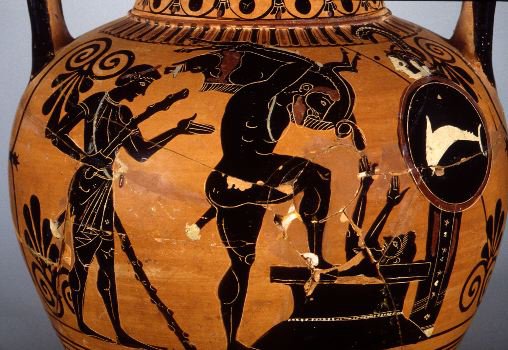So basically, Hercules did some bad things like killing his sons and stuff because Hera, who hated that one of Zeus's affairs led to the birth of such a powerful son, drove him mad. To make up for his crimes, he had to serve King Eurystheus, and the king gave him the following labors.
1.) Killing the Nemean Lion
Basically, was a lion with impenetrable fur. Hercules didn't need to pierce his skin to kill it, however. He just bashed its head with a skull and choked it.
2.) Killing the Hydra
Sam already described this one, but here's a quick recap. Everytime Hercules cut one of its heads, two more would grow in its place. To get around this dilemma, Hercules got his nephew, Iolaus, to burn the stumps so the heads couldn't grow back. Eurystheus didn't count this, however, because Iolaus helped him.
3.) Catching the Ceryneian Stag
So there was this super-fast deer with golden antlers that could even outrun arrows, and Hercules was told to bring back these antlers. To do so, he had to chase the deer around for an entire year before he finally caught it.
4.) Catching the Erymanthian Boar
For this task, Hercules got the advice of Chiron. Listening to Chiron's instructions, he easily caught the boar in the winter. When he got back to Eurystheus, the king was so afraid that he jumped in this really nasty pot. (see picture)

5.) Cleaning the Augean Stables
This guy Augeas had a bunch of immortal cattle and a giant stable that hadn't been cleaned in several years. When Hercules was told to clean it, he changed the path of a river and simply washed away all the filth. Eurystheus said this didn't count, though, because the use of a river was cheating.
6.) Killing the Stymphalian Birds
The stymphalian birds were the birds with bronze teeth and sharp feathers that they could shoot out. Hercules couldn't get to them because they excreted toxic material and lived in a swamp that could not support his weight. Athena helped him out, giving him a rattle made by Hephaestus to scare the birds out of hiding. When they can out, Hercules shot them with his bow.
7.) Catching the Cretan Bull
The Cretan Bull was just a giant bull that was causing havoc in Crete. He just snuck up behind it and beat it up, not much to say about that.
8.) Stealing the Mares of Diomedes
These were not normal horses he had to steal, but fire-breathing, man-eating horses. Also,if it is the same Diomedes as in the Aeneid, he was a very powerful Greek warrior, and he would have beaten the mighty Aeneas, had not Venus come down and carried him away to safety. After Hercules freed the horses, he tamed them by feeding Diomedes to them.
9.) Getting the Girdle of Hippolyta
This should have been easy because Hippolyta had heard of Hercules's exploits and was willing to give him the girdle, but personified rumor came down and told Hippolyta's people that he was there to kidnap her. When her people came to see what was going on, Hercules thought it was a trap so he killed Hippolyta and ran off with her girdle.
10.) Getting the Cattle of Geryon
Geryon was the three-bodied giant we talked about in class. Hercules shot him in the head with arrow and stole his cattle.
11.) Retrieve the Apples of the Hesperides
The Hesperides were the daughters of Atlas. He found them by catching Proteus and forcing him to tell him where they were. He got the apples by convincing Atlas to get apples and by holding the sky up while he did so.
12.) Capturing Cerberus
We already talked about this one in class. He went down and captured him without using weapons, wrestling him to the ground. While there he also freed Theseus, who was trapped with Pirithous in the underworld for trying to capture Proserpina.






